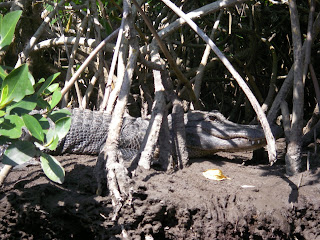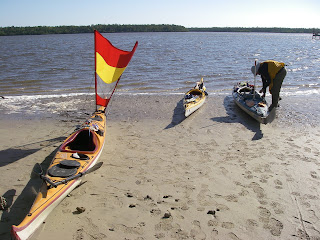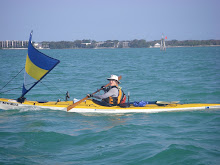 So what did I eat during the WaterTribe Everglades Challenge. Some folks wanted to know (thanks, Craigcanoer).
So what did I eat during the WaterTribe Everglades Challenge. Some folks wanted to know (thanks, Craigcanoer).I’m the type of person that if I don’t nibble regularly – about every four hours – I tend to fall over – and that’s sitting at my office desk. This was my biggest concern prior to the EC – how to keep my fire stoked so I could keep paddling non-stop for 12 to 16 hours. In the end, I had no problems – but I’d spent some time beforehand sorting out just what I would need to keep myself going.
With the research that I did, I figured I’d need 200-300 carbohydrate-calories per hour to keep up my endurance. A body’s system can only metabolize about 350 calories per hour, thus my target was to eat 30-60gms of carbs an hour – one can’t digest anything more than that.
So I planned accordingly.

In a small Sea to Summit dry bag I packed breakfast – five dried apricots and two muesli bars for each morning. These were eaten on the go as I packed up camp (mostly around 0400-0430) or perhaps even on the water. If I hadn’t needed to drink an Ensure the night before, I had that before casting off from the beach.
I packed in a large ziplock bag each day’s food, and stored all that in another Sea to Summit dry bag – it weighed a massive 10lbs/4.5kgs. Each day I’d pop one ziplock into my Macpac bumbag, clipped around my waist, sitting on top of my spray skirt – so instantly accessible. I figured that I needed to eat at least every hour, and that would mean at least 16 energy bars and Gu per bag, per day. I way over estimated, even though I felt I was eating very regularly – I suppose time does fly when you’re having fun. But I never felt hungry, so they did the trick. In the end, each day’s bag probably lasted me not quite two days.
Here’s what I had in each ziplock:
6 x Clif Bars
4 x Gu shots and 1 coffee Clif shot (didn’t like the latter; I don’t drink coffee)
2 x Moro bars (NZ - yum)
1 x Luna Bar
1 x Honey Bar Natural (yum)
3 x Natural Valley Oats ‘n Honey (bought bulk from Costco, half if not less the weight of a Clif bar, a bit dryish, but overall my favourite – I’ll take more of those next year)
Clif Bars were my main source of energy. I had a variety, ranging from Oatmeal Raisin Walnut to Chocolate Brownie. I tired of them pretty quickly (aah, day 2), but kept eating them as they caused no intestinal trouble and my bodily functions (I’m trying to be polite here) worked perfectly every (early) morning for the entire race.
The Gu shots were
 mainly consumed during the last few hours of the day when I needed an quick-and-easily digestible energy boost. Surprisingly, I didn’t use as many of them as I thought I would – I had a lot left over.
mainly consumed during the last few hours of the day when I needed an quick-and-easily digestible energy boost. Surprisingly, I didn’t use as many of them as I thought I would – I had a lot left over.I also had a few bags of Target-branded beef jerky (my favourite taste-wise) and string cheese. Over a period of time, having some dairy product is really important for the body. But I surprised myself how little I really ate of both – most came home with me.
As soon as possible after hitting the beach at the end of the day, and certainly within 20 minutes, I drank 750mls/12ozs of Endurox R4. I had each day’s powder pre-packed in a small ziplock bag. I did try the Fruit Punch taste post-purchase and before I left for the EC, and hated it, but I wasn’t about to spend another $x on another container. (Perhaps REI could do pre-buy tastings…) By the end of a hard day, I didn’t really care – it did the job.
For most dinners I’d boil up a few cups of water and eat a Mountain House, two-person-serving of freeze-dried Stroganoff with Beef & Noodles – 620cals (I’m a creature of habit and can eat this particular flavour for days on end). I brought seven of the dinners along and ate all but one, though one night I could only finish half a bag. Before the race, I took off each dinner’s top tear-tab, took out the thing-a-me inside, pushed out the air and resealed the pouch by its own thread – every gram counts. And just before I hit my pit, I’d drink a bottle of Ensure (250cals). All the dinners and seven bottles of Ensure were stored in another Sea to Summit dry bag. I had one bottle of Ensure left over by race end (and gave that to SandyBottom for our last day’s breakfast).
I hydrated constantly all day. My bladder’s never been the best one off the shelf for expansion properties, but at least I wasn’t not urinating. The only time I drank pure water was at night in my tent. For the rest of the race I sipped fairly constantly – about every 10 minutes or so – on Gookinaid. I met Bill Gookin about five years ago when living in San Diego, and I’m a true convert to the benefits of his product. My MSR dromedaries were 4-litres, which meant 16 scoops of Gookinaid per water bag. I had each 4-litres pre-scooped into ziplock bags, and planned on two four-litre water bags per day. All those ziplocks were stored in their own Sea to Summit dry bag. In the end I only drank about two to three litres a day, so had lots of Gookinaid powder left over - and all that Gookinaid was pretty heavy.
All-in-all, I felt very comfortable with what I'd brought along, and had no health or hunger issues whatsoever. With the extra weight, which will be pared down for next year, I convinced myself that it all helped contribute to a longer waterline...






















































